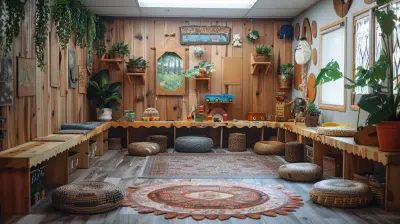The Flexibility of Distance Education: A New Era for Adult Learners
29 June 2025
Let’s face it: the idea of going back to school can be downright intimidating, especially for adults juggling full-time jobs, family responsibilities, and everything else life throws at them. But that’s where the magic of distance education steps in. This isn’t your traditional classroom setup. We’re talking about a whole new era that gives adult learners the freedom to chase their academic and career goals—on their own terms.
Distance education has come a long way in just a few short years. It’s no longer a second-tier alternative to in-person learning. In fact, it’s becoming the first choice for many. And why not? The flexibility, accessibility, and affordability it offers make it a dream come true for anyone trying to balance life and learning.

What Is Distance Education, Anyway?
Before we dive in deeper, let’s clear up what distance education really is. At its core, it’s a mode of learning that takes place away from a traditional classroom. Instead of attending lectures in person, students learn online—through videos, forums, digital textbooks, and interactive platforms.Sure, it used to be known as "correspondence courses" where materials came in the mail. But now, thanks to technology, it’s a dynamic, engaging, and fully interactive way to study.
So, what makes it so appealing—especially for adults? Let’s crack that open.

Why Adults Are Turning to Distance Education
1. Flexibility That Actually Works Around Your Life
This is the big one. Flexibility is the crown jewel of distance education.If you’ve got a 9-to-5 job, kids to drop off at school, or other commitments, traditional college schedules just don’t cut it. Distance learning lets you log in when you can—whether that’s early in the morning before your coffee kicks in or late at night when the house is quiet.
No long commutes. No rigid class times. Just education that fits your schedule.
2. Learn at Your Own Pace
Feel like you blinked and missed a lecture? With online courses, you can pause, rewind, and replay lectures as many times as you need. You get to decide your learning speed. Want to breeze through a module you already know? Go for it. Need more time on a tough topic? No problem.This kind of self-pacing is a game changer—especially if it's been a while since you were last in a classroom.
3. Accessibility for All
Whether you’re living in a small town, a busy city, or even overseas, distance education opens up opportunities that might not have been accessible otherwise. You no longer have to relocate or uproot your life to attend a top university. Just a stable internet connection and a laptop, and you’re good to go.Oh, and for people with disabilities, online learning can provide more accommodating and inclusive environments. It removes physical barriers and gives everyone a fair shot at success.
4. Budget-Friendly Education
Let’s talk money—because that’s often a big concern.Distance education often comes with a lower price tag. There are no commuting costs, no campus housing, and plenty of digital materials that save you from spending hundreds on textbooks. Plus, many online programs offer pay-as-you-go models, which is perfect if you’re trying to avoid student loan debt.
5. Diverse Course Options
From degrees in business administration to certifications in IT, health sciences, and creative writing, the course offerings are vast and varied. You can take university-level courses from institutions across the world, specialized training for your job, or personal development classes—all from the comfort of your couch.
The Tech Behind the Flexibility
Technology has been the real MVP here. Without modern tools and platforms, distance education just wouldn’t work.Let’s break down some of the tech that's making it all happen:
- Learning Management Systems (LMS) like Moodle, Blackboard, and Canvas organize everything in one place—assignments, lectures, quizzes, forums.
- Video conferencing tools like Zoom and Google Meet bring real-time interaction when needed.
- Discussion boards and chat groups keep everyone connected and engaged.
- Mobile-friendly platforms let you learn on the go, from your couch or your car (just not while driving, please!).
All these tools combine to make education not just accessible, but engaging.

Real-Life Balance: How Adults Make It Work
You might be wondering, “How do people actually manage this in real life?” Well, let’s paint a picture.Take Sarah, a 34-year-old working mom who’s always wanted to finish her degree in psychology. Between work and playdates, she couldn’t possibly attend an in-person university. But with distance education, she studies during nap times and in the evenings. She watches recorded lectures, submits assignments online, and even joins live group discussions when she can.
Or consider Marcus, a 45-year-old factory supervisor. His job is exhausting, but he dreams of moving into management. He signs up for a part-time online MBA and chips away at the coursework during weekends. Slowly but surely, he's making it happen.
These stories are becoming more common—and they’re proof that distance education isn’t just possible, it’s powerful.
Challenges? Sure, But They’re Beat-Able
Let’s not sugarcoat it—distance education isn’t always a walk in the park.1. Time Management Is Key
Without physical classes to attend, you’re in charge of your schedule. That means you need to be disciplined. It's easy to procrastinate when no one's watching. Setting reminders, planning weekly goals, and using apps like Todoist or Trello can help you stay on track.2. Digital Literacy Matters
You don’t need to be a tech wizard, but basic digital skills are a must. Some older adults might find this scary, but most platforms are user-friendly and come with tutorials. Don’t let tech fears stop you.3. Isolation Can Happen
Let’s be honest—learning alone can get lonely. But there are plenty of ways to stay connected. Join discussion boards, attend live virtual sessions, or even form online study groups. Community is still possible—it just looks a little different.
Employers Are Taking Notice
Gone are the days when online degrees were seen as less credible. Many reputable institutions now offer distance programs, and employers are finally catching up. In fact, they’re often more impressed by adults who return to school online—it shows initiative, time management, and a hunger to grow.Plus, a lot of distance programs are industry-aligned, so you're learning skills that are directly relevant to the job market.
Distance Education and Lifelong Learning
Let’s step back a bit. Why are adults learning in the first place?Because learning doesn't stop when you leave school. Whether it’s for career advancement, a change in profession, or just personal development, education is a lifelong journey. Distance education fuels that journey.
It’s like having a GPS for your goals—guiding you through twists and turns without needing to stop your life.
Distance Learning During the Pandemic—and Beyond
The COVID-19 pandemic didn’t invent online learning, but it sure put it on the fast track. When everything went remote, millions of adults got their first taste of distance education—and many found it surprisingly effective.Now that we’ve had a taste, the appetite for online learning is only growing. More schools are developing online programs. More employers are encouraging it. And more learners are realizing that education is truly within reach.
What the Future Looks Like
The future of distance education? It’s bright—and getting brighter.We’re seeing:
- More interactive tech (hello, AI assistants and VR classrooms!)
- Greater support services like online tutoring and mental health counseling
- Micro-credentials and shorter certificate programs that offer quick wins
- Global classrooms, where you're learning alongside people from different parts of the world
It’s not just about convenience. It’s about creating a smarter, more inclusive, and more flexible way to educate.
Final Thoughts
Distance education isn’t just a backup plan anymore. It’s a lifeline—for busy adults, career changers, parents, and anyone else who wants to learn while living their life fully.It allows you to move forward without hitting pause on everything else. That’s powerful. That’s the future.
So if you’ve been dreaming about going back to school but talking yourself out of it... maybe it’s time to give distance learning a chance. Your goals haven’t gone anywhere—they’ve just been waiting for the right kind of classroom.
And now, that classroom fits in your pocket.
all images in this post were generated using AI tools
Category:
Distance EducationAuthor:

Madeleine Newton
Discussion
rate this article
2 comments
Velma McInnes
This article beautifully highlights the transformative potential of distance education for adult learners. The flexibility it offers not only accommodates various life commitments but also empowers individuals to pursue their educational goals. Exciting times lie ahead for lifelong learning!
November 7, 2025 at 12:42 PM

Madeleine Newton
Thank you for your thoughtful comment! I'm glad you found the article highlights the empowering nature of distance education for adult learners. Exciting times indeed!
Samira McLaurin
What an exciting era for adult learners! The flexibility of distance education opens up endless opportunities to learn and grow. It's fantastic to see how technology empowers individuals to balance education with life commitments. Cheers to lifelong learning and embracing new possibilities!
July 9, 2025 at 10:16 AM

Madeleine Newton
Thank you! I completely agree—distance education truly revolutionizes learning, making it accessible and manageable for adults juggling various commitments. Here’s to lifelong learning!


